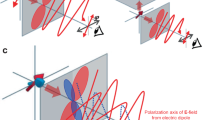Abstract
A complete understanding of any complex molecular system generally requires a knowledge of the three-dimensional (3D) orientation of its components relative both to each other, and to directional perturbations such as interfaces and electromagnetic fields. Far-field polarization microscopy is a convenient and widespread technique for detecting and measuring the orientation of single chromophores. But because the polarized electromagnetic field that is used to probe the system lacks a significant longitudinal component, it was thought that, in general, only 2D orientation information could be obtained1,2,3. Here we demonstrate that far-field polarization microscopy can yield the 3D orientation of certain highly symmetric single chromophores (CdSe nanocrystal quantum dots in the present case). The key requirement is that the chromophores must have a degenerate transition dipole oriented isotropically in two dimensions, which gives rise to a perpendicular ‘dark axis’ that does not couple to the light field. By measuring the fluorescence intensity from the dipole as a function of polarization angle, it is possible to calculate both the tilt angle between the dark axis and the sample plane, as well as the in-plane orientation, and hence obtain the 3D orientation of the chromophore
This is a preview of subscription content, access via your institution
Access options
Subscribe to this journal
Receive 51 print issues and online access
$199.00 per year
only $3.90 per issue
Buy this article
- Purchase on Springer Link
- Instant access to full article PDF
Prices may be subject to local taxes which are calculated during checkout




Similar content being viewed by others
References
Guttler, F. et al. Single molecule polarization spectroscopy: pentacene in p-terphenyl. Chem. Phys. 211, 421–430 (1996).
Macklin, J. J. et al. Imaging and time-resolved spectroscopy of single molecules at an interface. Science 272, 255–258 (1996).
Ha, T. et al. Single molecule dynamics studied by polarization modulation. Phys. Rev. Lett. 77, 3979–3982 (1996).
Betzig, E. & Chichester, R. Single molecules observed by near-field scanning optical microscopy. Science 262, 1422–1425 (1993).
Empedocles, S. A., Norris, D. J. & Bawendi, M. G. Photoluminescence spectroscopy of single CdSe nanocrystallite quantum dots. Phys. Rev. Lett. 77, 3873–3876 (1996).
Dickson, R. M., Norris, D. J. & Moerner, W. E. Simultaneous imaging of individual molecules aligned both parallel and perpendicular to the optic axis. Phys. Rev. Lett. 81, 5322–5325 (1998).
Sepiol, J., Jasny, J., Keller, J. & Wild, U. P. Single molecules observed by immersion mirror objective. The orientation of terrylene molecules via the direction of its transition dipole moment. Chem. Phys. Lett. 273, 444–448 (1997).
Bopp, M. A. et al. Single-molecule spectroscopy with 27 fs pulses: time-resolved experiments and direct imaging of orientational distributions. Appl. Phys. Lett. 73, 7–9 (1998).
Callomon, J. H., Dunn, T. M. & Mills, I. M. Rotational analysis of the 2600 Å absorption system of benzene. Phi. Trans. R. Soc. Lond. A 259, 499–532 (1966).
Kneipp, K. et al. Single molecule detection using surface-enhanced raman scattering (SERS). Phys. Rev. Lett. 78, 1667–1670 (1997).
Empedocles, S. A. & Bawendi, M. G. Quantum-confined Stark effect in single CdSe nanocrystallite quantum dots. Science 278, 2114–2117 (1997).
Tittel, J. et al. Investigations of the emission properties of single CdS-nanocrystallites. Ber. Bunsenges. Phys. Chem. 101, 1626–1630 (1997).
Murray, C. B., Norris, D. J. & Bawendi, M. G. Synthesis and characterization of nearly monodisperse CdE (E = S, Se, Te) semiconductor nanocrystallites. J. Am. Chem. Soc. 115, 8706–8715 (1993).
Efros, Al. L. Luminescence polarization of CdSe microcrystals. Phys. Rev. B 46, 7448–7458 (1992).
Efros, Al. L. et al. Band-edge exciton in quantum dots of semiconductors with a degenerate valence band: dark and bright exciton states. Phys. Rev. B 54, 1–14 (1996).
Shaing, J. J. et al. Symmetry of annealed wurtzite CdSe nanocrystals: assignment to the C3vpoint group. J. Phys. Chem. 99, 17417–17422 (1995).
Franceschetti, A., Fu, H., Wang, L. W. & Zunger, A. Many-body pseudopotential theory of excitons in InP and CdSe QDs. Phys. Rev. B. (in the press).
Leung, K., Pokrant, S. & Whaley, K. B. Exciton fine structure in CdSe nanoclusters. Phys. Rev. B 57, 12291–12301 (1998).
Kovalev, E. et al. Optically induced polarization anisotropy in porous Si. Phys. Rev. Lett. 77, 2089–2092 (1996).
Bruchez, M. Jr. et al. Semiconductor nanocrystals as fluorescent biological labels. Science 281, 2013–2016 (1998).
Chan, C. W. & Nie, S. Quantum dot bioconjugates for ultrasensitive nonisotopic detection. Science 381, 2016–2018 (1998).
Hines, M. A. & Guyot Sionnest, P. Synthesis and characterization of strongly luminescing ZnS-capped CdSe nanocrystals. J. Phys. Chem. 100, 468–471 (1996).
Dabbousi, B. O. et al. (CdSe)ZnS core-shell quantum dots: synthesis and characterization of a size series of highly luminescent nanocrystallites. J. Phys. Chem. B 101, 9463–9475 (1997).
Fattinger, C. & Lukosz, W. Optical-environment-dependent lifetimes and radiation patterns of luminescent centers in very thin films. J. Lumin. 31&32, 933–935 (1984).
Acknowledgements
We thank A. P. Efros for discussions. S.A.E. thanks the Lester Wolfe Foundation and Eastman Chemical Co. for fellowships. This work was funded in part by the NSF-MRSEC program and the AT&T Foundation. We thank the M.I.T. Harrison Spectroscopy laboratory for support and for use of its facilities.
Author information
Authors and Affiliations
Corresponding author
Rights and permissions
About this article
Cite this article
Empedocles, S., Neuhauser, R. & Bawendi, M. Three-dimensional orientation measurements of symmetric single chromophores using polarization microscopy. Nature 399, 126–130 (1999). https://doi.org/10.1038/20138
Received:
Accepted:
Issue Date:
DOI: https://doi.org/10.1038/20138
This article is cited by
-
Direct nano-imaging of light-matter interactions in nanoscale excitonic emitters
Nature Communications (2023)
-
Semiconductor nanomaterial-based polarized light emission: From materials to light emitting diodes
Science China Materials (2023)
-
Measuring 3D orientation of nanocrystals via polarized luminescence of rare-earth dopants
Nature Communications (2021)
-
Integrated polarization-sensitive amplification system for digital information transmission
Nature Communications (2021)
-
Polarizer-free polarimetric image sensor through anisotropic two-dimensional GeSe
Science China Materials (2021)
Comments
By submitting a comment you agree to abide by our Terms and Community Guidelines. If you find something abusive or that does not comply with our terms or guidelines please flag it as inappropriate.



